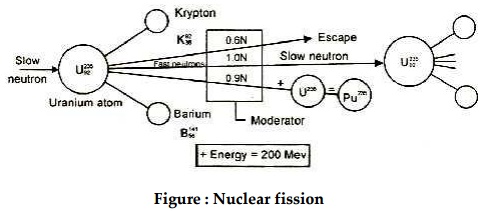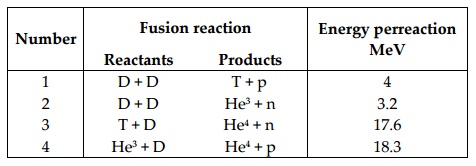(a)Fission Energy (b) Chain Reaction (c) Fusion Energy
A nuclear power plant is similar to a conventional steam power plant except how that energy is evolved. The heat is produced in the nuclear power plant by fission, whereas in steam and gas turbine plants, the heat is produced by combustion in the furnace. The nuclear reactor acts as a furnace where nuclear energy is evolved by splitting or fissioning of the nucleus of fissionable material like Uranium U-235. It is claimed that 1 kg U-235 can produce as much heat energy that can be produced by burning 4500 tones of high grade coal or 1700 tons of oil.
Fission energy

Nuclear energy is divided from splitting (or) fissioning of the nucleus of fissionable material like Uranium U-235. Uranium has several isotopes (Isotopes are atoms of the same element having different atomic masses) such as U-234, U-235 and U-238. Of the several isotopes, U-235 is the most unstable isotope, which is easily fissionable and hence used as fuel in an atomic reactor.
When a neutron enters the nucleus of an unstable U-235, the nucleus splits into two equal fragments (Krypton and Barium) and also releases 2.5 fast moving neutrons with a velocity of 1.5×107 m/sec and along with this produces a large amount of energy, nearly 200 million electro-volts. This is called nuclear fission.
1. Chain reaction
The neutrons released during fission are very fast and can be made to initiate the fission of other nuclei of U-235, thus causing a chain reaction. When a large number of fission occurs, enormous amount of heat is generated, which is used to produce steam.
The chain reaction under controlled conditions can release extremely large amount of energy causing ‚atomic explosion‛
Energy released in chain reaction, according to Einstein law is
E = mc2
Where E = Energy liberated (J) m= Mass (kg)
c = Velocity of light (3 × 108 m/sec).
Out of 2.5 neutrons released in fission of each nucleus of U-235, one neutron is used to sustain the chain reaction, about 0.9 neutron is captured by U-238, which gets converted into fissionable material Pu-239 and about 0.6 neutron is partially absorbed by control rod materials, coolant and moderator.
If thorium is used in the reactor core, it gets converted to fissionable material U-233.
Thorium 232 + Neutron ® U-233
Pr-239 and U-233 so produced are fissionable materials are called secondary fuels. They can be used as nuclear fuels. U-238 and Th-232 are called fertile materials.
2. Fusion energy
Energy is produced in the sun and stars by continuous fusion reactions in which four nuclei of hydrogen fuse in a series of reactions involving other particles that continually appear and disappear in the course of the reaction, such as He3, nitrogen, carbon, and other nuclei, but culminating in one nucleus of helium of two positrons.
® 41 H 1 +2+1 e 4 0
® 2 He
To cause fusion, it is necessary to accelerate the positively charged unclei to high kinetic energies, in order to overcome electrical repulsive forces, by raising their temperature to hundreds of millions of degrees resulting in plasma. The plasma must be prevented from contacting the walls of the container, and must be confined for a period of time (of the order of a second) at a minimum density. Fusion reactions are called thermonuclear because very high temperatures are required to trigger and sustain them. Table lists the possible fusion reactions and the energies produced by them. n, p, D, and T are the symbols for the neutron, proton, deuterium (H2), and tritium (H3), respectively.
Number Fusion reaction Energy perreaction (MeV
)
Reactants Products
1 D + D T + p 4
2 D + D He3 + n 3.2
3 T + D He4 + n 17.6
4 He3 + D He4 + p 18.3

Many problems have to be solved before an artificially made fusion reactor becomes a reality. The most important of these are the difficulty in generating and maintaining high temperatures and the instabilities in the medium (plasma), the conversion of fusion energy to electricity, and many other problems of an operational nature.

